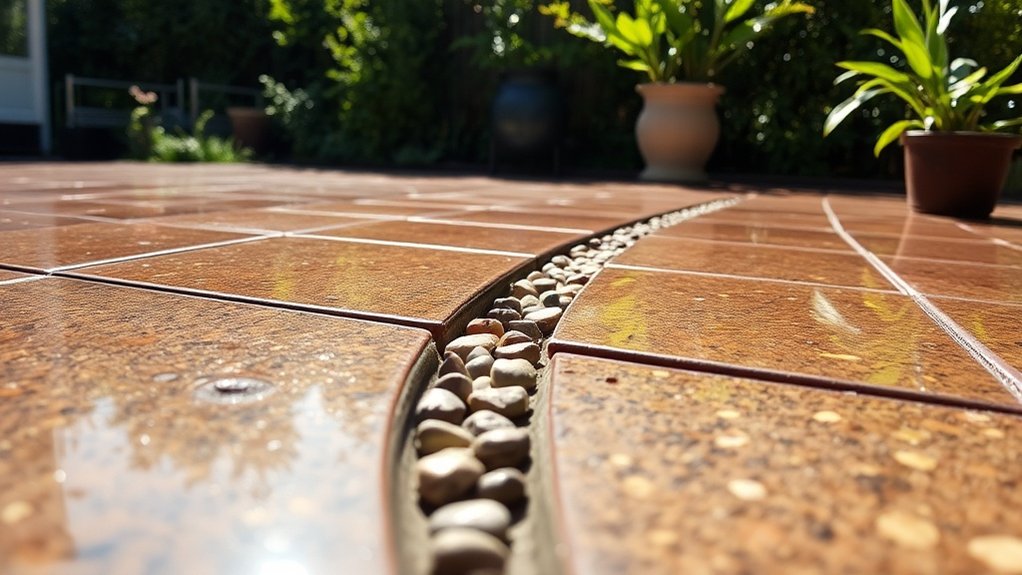To ensure proper drainage for your resin-bound patio, begin with a well-prepared sub-base that’s at least 100mm thick, using MOT Type 3 materials. Create a gradient with a minimum fall of 1-2% to direct water away from buildings. Install drainage channels at low points for effective water management, and opt for UV-stable resins to enhance durability and drainage. Regular maintenance, such as sweeping and washing with a hose, will help keep your patio in good shape. There’s plenty more advice available on improving your patio’s performance.
Key Takeaways
- Ensure a minimum gradient of 1-2% during installation to direct water away from buildings and avoid pooling.
- Use a well-compacted MOT Type 3 sub-base, at least 100mm thick, to improve drainage and provide structural support.
- Install drainage channels at low points, making sure they align with the patio slope for effective water management.
- Keep the patio well-maintained by sweeping away debris and checking for moss or pooling to maintain permeability.
- Inspect the subsurface layers for any compaction issues and confirm the gradient regularly to ensure efficient water flow and prevent blockages.
Understanding the Permeability of Resin-Bound Patios
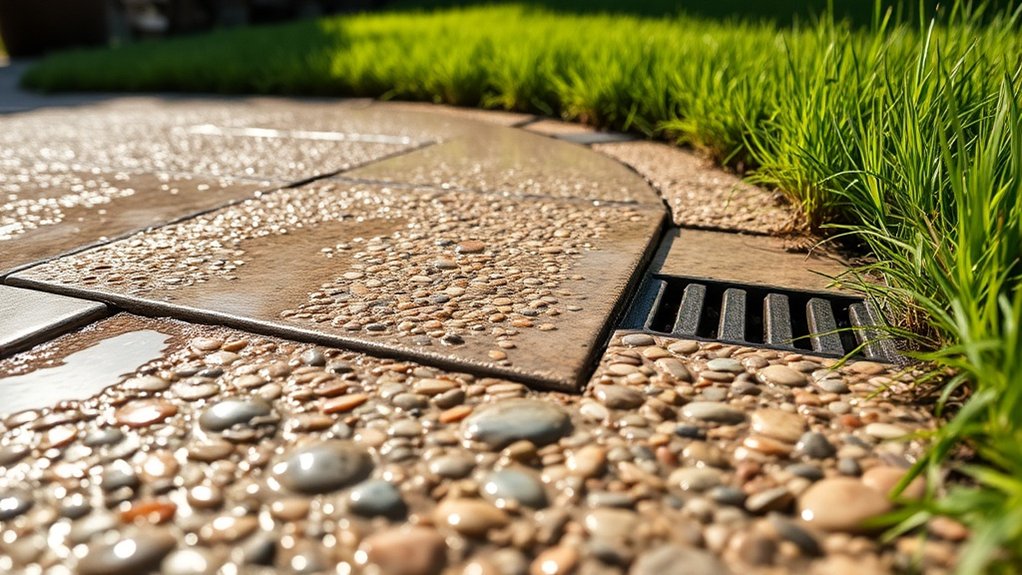
When considering a resin-bound patio, it’s important to understand its permeability. This type of surface, made from natural aggregates and clear resin, allows up to 95% of rainwater to drain through, improving drainage efficiency significantly. Factors such as the size and ratio of aggregates affect how well water flows, turning the patio into a natural drainage system. Tiny pores in the surface enable vertical drainage into the sub-base, which helps prevent puddles and waterlogging. Proper sub-base installation is essential for effective drainage in resin-bound patios. Resin-bound patios also comply with Sustainable Urban Drainage Systems (SuDS) standards, promoting environmentally friendly practices while keeping your outdoor area safe. A properly installed patio effectively manages surface water and even helps replenish groundwater, making it a sensible choice for any outdoor space. Additionally, resin-bound patios are known for their durability and minimal upkeep, ensuring they remain functional and attractive over time.
Importance of Sub-Base Preparation
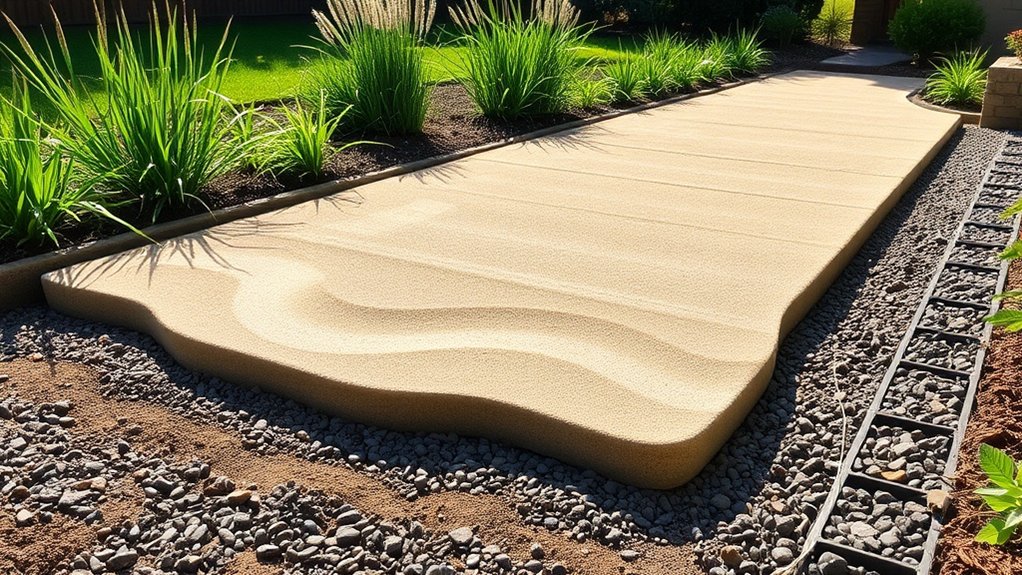
Preparing your sub-base is crucial for a solid, level foundation that supports your resin-bound patio. It’s important to create a proper gradient to ensure effective water drainage, which helps avoid future problems. Neglecting this step can lead to surface issues, so make sure to prioritise this vital part of your project. A minimum thickness of 100mm for the base layer is essential to provide the necessary support for the resin surface. Additionally, using MOT Type 3 for your sub-base will enhance drainage and ensure compliance with SuDS standards.
Firm, Level Foundation
A firm, level foundation is crucial for the durability and performance of a resin-bound patio. Proper preparation of the sub-base ensures effective moisture management and structural integrity.
Here are three key points to consider:
- Compaction: Use a plate compactor to create a dense sub-base. This helps prevent cracking and deformation in the future.
- Materials: Choose MOT Type 3 aggregate for its excellent drainage and stability. Ensure the sub-base is at least 150mm thick for optimal support. The choice of sub-base material directly impacts the longevity and effectiveness of the installation.
- Levelness: Keep the surface even to prevent weak spots and water pooling. Flat-edged rakes or laser levels can help achieve precision in your work.
Proper Gradient Design
Proper gradient design is crucial for ensuring effective drainage on resin-bound patios, as it directly impacts water runoff and usability of the surface. A well-executed gradient improves drainage efficiency and reduces the likelihood of water pooling.
| Gradient Specification | Description | Benefits |
|---|---|---|
| Minimum Fall | 1-2% (1-2cm per metre) | Ensures adequate water flow |
| Direction | Away from buildings and structures | Prevents water ingress problems |
| Consistency | Uniform slope without abrupt changes | Stops water from being trapped |
| Material Compatibility | Permeable sub-base materials | Supports Sustainable Drainage Systems (SuDS) compliance |
| Maintenance | Regular inspections and debris removal | Maintains drainage effectiveness |
Effective drainage is further enhanced by employing sub-base requirements such as a properly compacted foundation.
Designing the Correct Gradient for Drainage
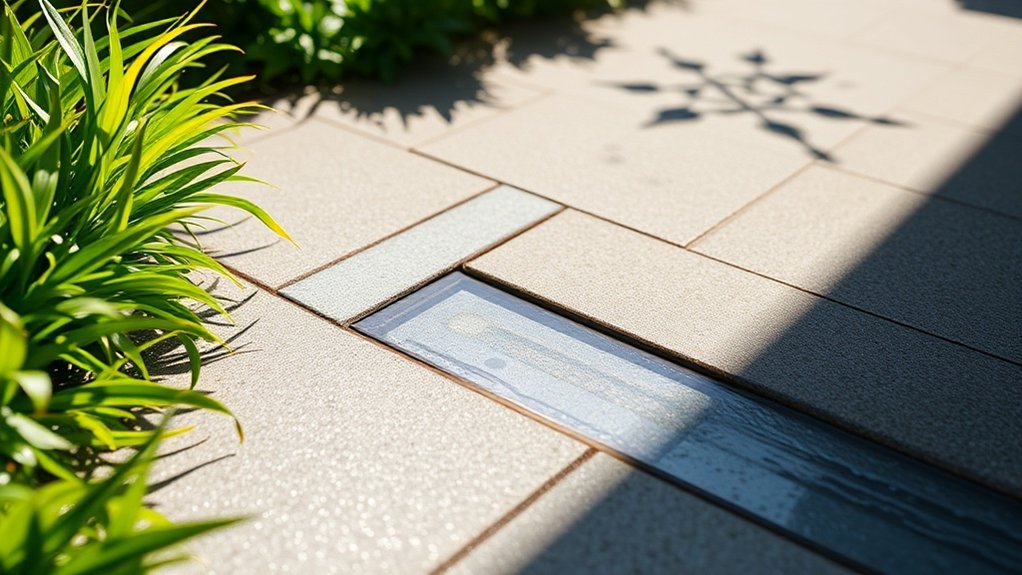
To ensure effective drainage for your resin-bound patio, it’s crucial to design the gradient correctly from the start. Here are three key points to consider:
- Aim for a slope between 1:12 (8.3%) and 1:40 (2.5%) to facilitate proper water runoff without making the surface too steep.
- Carry out a detailed site assessment to understand the natural drainage patterns and steer clear of any low-lying areas.
- Build a robust sub-base using compacted MOT Type 3 aggregate to keep the gradient intact under weight.
Implementing these drainage strategies will help prevent water pooling, reduce algae growth, and ensure a durable and safe patio.
Don’t forget to conduct regular maintenance checks to catch any issues early on.
Integrating Effective Drainage Systems and Channels
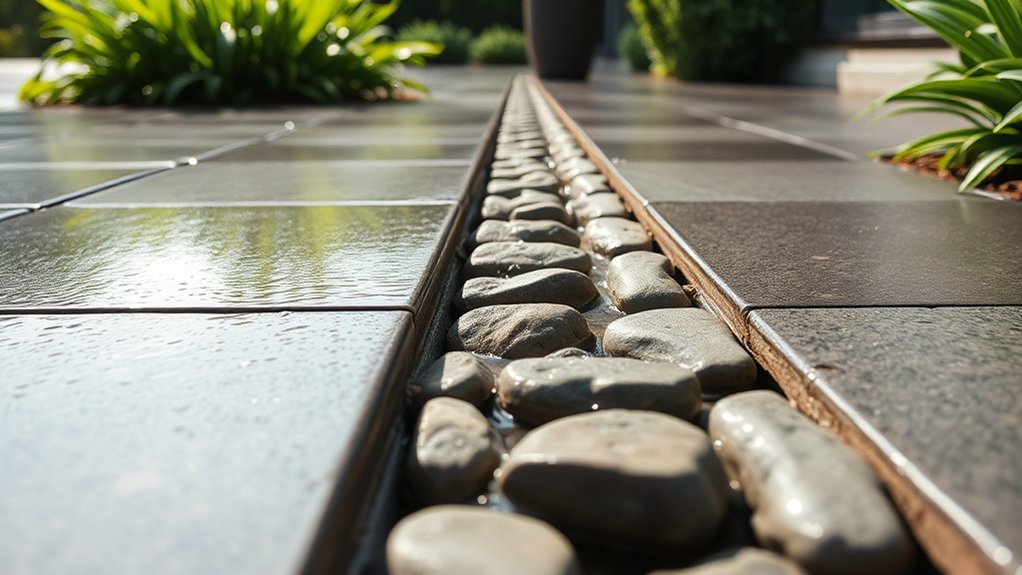
To ensure proper drainage for your resin-bound patio, strategically position drainage channels to direct water away from the surface.
It’s important to connect these channels to existing drainage systems to manage water flow effectively and prevent overflow.
Regular maintenance is crucial; it keeps your drainage system working well over time.
Drainage Channel Placement
When planning drainage channels for your resin-bound patio, it’s crucial to assess natural water flow patterns to ensure effective drainage and protect your patio’s integrity.
Consider these three key points:
- Position channels at low points or edges where water collects.
- Align channels with the patio’s natural slope, maintaining a gradient of 1–2% away from buildings.
- Choose the right type of drainage channels, such as Aco or channel drains, to meet your needs.
For optimal results, install channels flush with the surface to enhance durability and comply with sustainable drainage guidelines.
Connection to Existing Systems
Integrating effective drainage systems into your resin-bound patio enhances both its functionality and water management. Connecting to existing systems optimises these solutions and prevents water accumulation.
| System Type | Description |
|---|---|
| Channel Drains | Fitted along edges to collect surface water. |
| Soakaways | Allow excess water to seep back into the ground. |
| French Drains | Redirect water away using gravel-filled trenches. |
| Horizontal Drainage | Manages water flow in poorly sloped areas. |
| Drainage Pipe Connections | Improve efficiency by linking to existing pipes. |
Regular Maintenance Practices
To ensure your drainage systems and channels work effectively and prevent water build-up, regular maintenance is essential. Here are some key practices to keep your resin-bound patio in top shape:
- Regular Cleaning: Sweep the patio with a stiff broom and wash it gently with mild detergent to avoid any blockages.
- Debris Clearance: Frequently remove leaves, dirt, and moss using non-metal tools like leaf blowers to protect the surface.
- Inspect the Subsurface: Check the drainage layers to ensure they’re not compacted and that the gradient slopes are correct for efficient water flow.
Choosing the Right Materials for Maximum Drainage
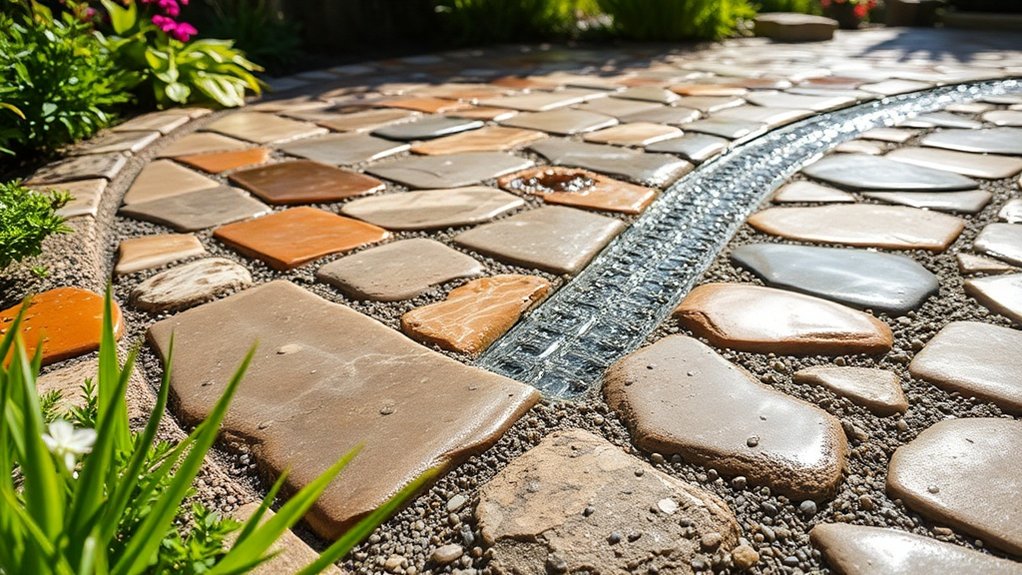
Choosing the right materials for a resin-bound patio is crucial for ensuring good drainage and durability. Start with your aggregate; select high-quality, coarse, angular stones to improve permeability. When these aggregates are mixed with resin on-site, they enhance porosity, creating a seamless surface that efficiently drains water through tiny pores.
Make sure your resin is top-notch. Use UV-stable, polymer-bound resins that retain their binding strength while allowing for effective drainage. The right resin formulation also controls curing times, which helps prevent pore blockage during installation.
Furthermore, a well-compacted MOT Type 3 sub-base is important as it supports the resin and promotes water percolation. A slight gradient will encourage runoff.
Maintaining Your Resin-Bound Patio for Optimal Performance
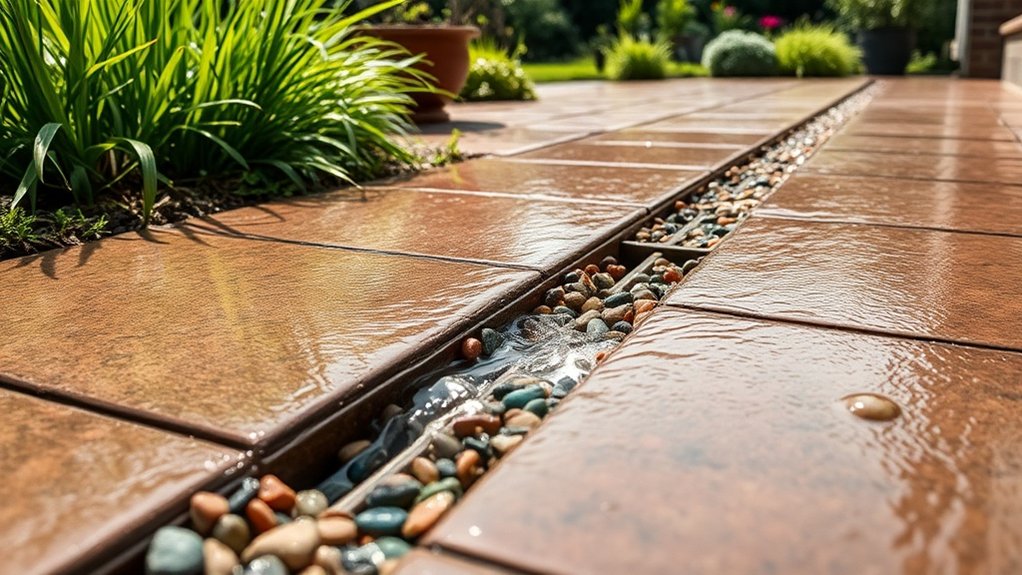
To keep your resin-bound patio in top shape, regular maintenance is key for its performance and longevity. Here are some straightforward steps to follow:
- Sweep regularly to remove leaves and debris, which can cause clogging and stains.
- Use a garden hose or a low-pressure washer to wash away dirt and maintain permeability.
- Inspect and clean it at least twice a year, particularly in spring and autumn, to catch any issues early.
It’s also important to clean up spills right away to prevent damage, and keep an eye out for weeds that could affect drainage.
Identifying and Addressing Common Drainage Issues
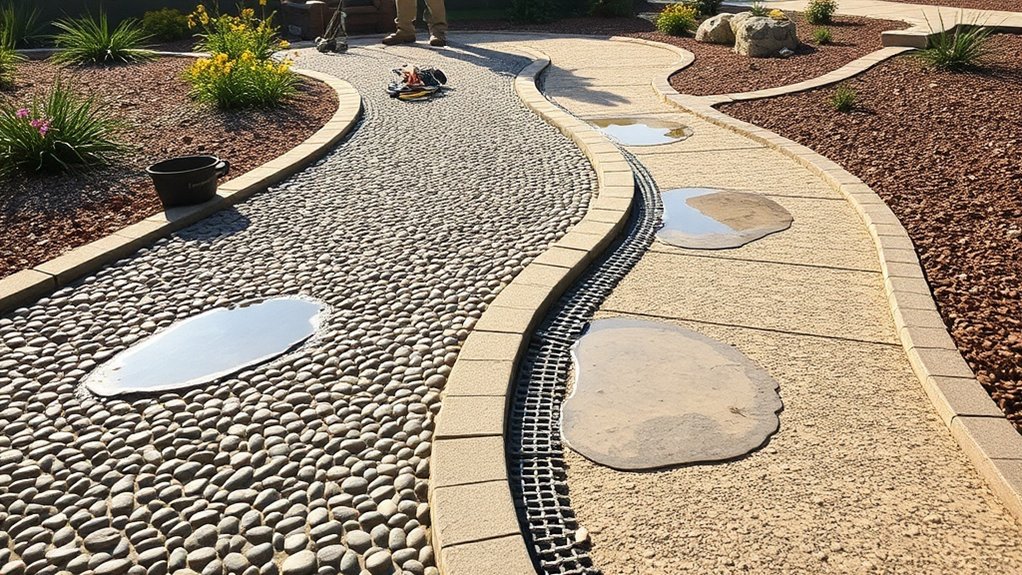
Regular maintenance is essential for a durable resin-bound patio, but drainage issues can still arise. If you notice water pooling after rain, it may be due to inadequate drainage. This can happen from using the wrong sub-base materials or poor installation techniques.
Look out for signs like moss or mildew, which indicate excess moisture. Discolouration or loose stones may also suggest drainage problems.
To troubleshoot effectively, check that your patio has the correct slope and consider adding drainage channels if needed. Make sure to regularly clear away debris to keep the surface permeable and prevent blockages.
Benefits of Proper Drainage in Resin-Bound Patios
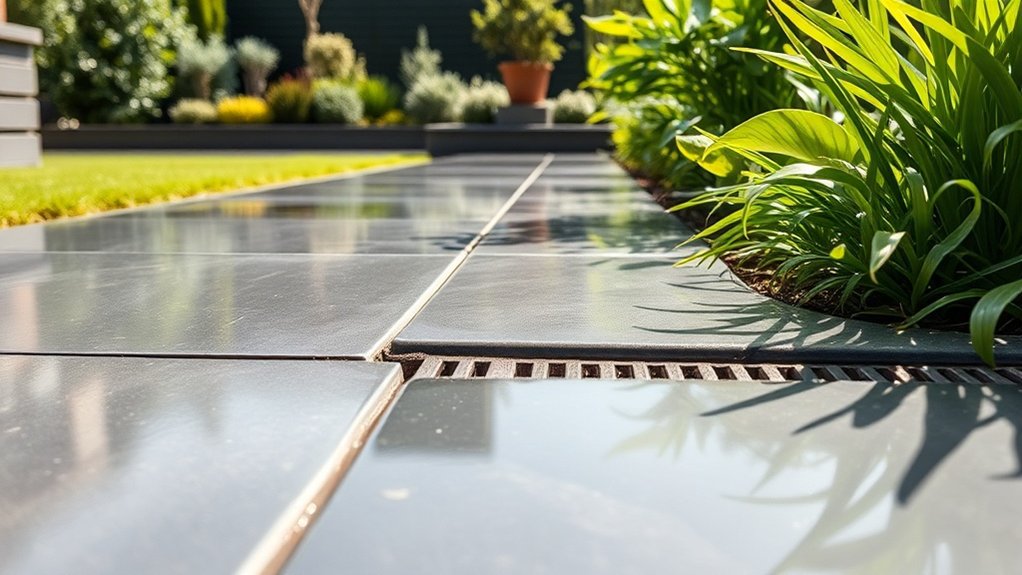
Ensuring proper drainage for your resin-bound patio significantly boosts its functionality and lifespan.
Effective drainage solutions not only protect your investment but also enhance the patio’s appearance.
Here are three key benefits:
- Flood Prevention: Good drainage reduces the risk of localized flooding, allowing water to pass through the surface efficiently.
- Sustainable Practices: Adhering to Sustainable Urban Drainage Systems (SUDS) helps manage stormwater and encourages natural groundwater recharge.
- Safety Enhancement: Adequate drainage prevents puddles, minimising slip hazards and creating a safer environment for everyone.
Frequently Asked Questions
Can Resin-Bound Patios Be Installed on Sloped Surfaces?
Yes, resin-bound patios can be installed on sloped surfaces. However, it’s essential to use proper installation techniques that take into account the angle of the slope and drainage needs. This ensures stability and prevents water pooling, which can enhance the patio’s longevity and overall performance. For instance, if you’re working on a garden slope, ensuring adequate drainage will keep your patio looking great and functioning well over time.
How Long Does It Take for a Resin-Bound Patio to Cure?
When curing a resin-bound patio, patience is essential. Generally, it takes between 24 to 36 hours for the patio to cure. However, factors like temperature and humidity can either speed up or slow down this process. For instance, a warm, dry day may expedite curing, while a cold, damp environment could extend it.
Are Resin-Bound Patios Suitable for Heavy Vehicle Traffic?
Resin-bound patios are not suitable for heavy vehicle traffic due to their porous nature, which can suffer from wear under significant weight. They can handle light loads, but regular use by heavy vehicles may lead to quicker deterioration and damage. For instance, if you plan to park a van or a larger vehicle regularly, it’s best to consider alternative paving options that are designed for such traffic.
What Colors and Finishes Are Available for Resin-Bound Patios?
Resin-bound patios come in a wide range of colours, from warm reds to earthy neutrals. You can choose from various finishes as well, with options that are smooth or subtly glossy. This variety allows you to create an attractive and personalised outdoor space for your home.
How Much Does a Resin-Bound Patio Installation Typically Cost?
A resin-bound patio installation generally costs between £50 and £100 per square metre. The overall price can vary due to factors such as the quality of materials, the condition of the base, and the size of the project. For instance, a larger area may lead to reduced costs per square metre, while a more complex base could increase expenses. It’s essential to consider these elements when budgeting for your patio.
Conclusion
In summary, ensuring proper drainage for your resin-bound patio is crucial for its durability and effectiveness. Understand the importance of permeability, prepare a solid sub-base, and incorporate reliable drainage systems to avoid water pooling and potential damage. Are you ready to put in the effort to maintain a patio that not only looks great but lasts for years? With the right approach, your outdoor space can be both beautiful and functional.
